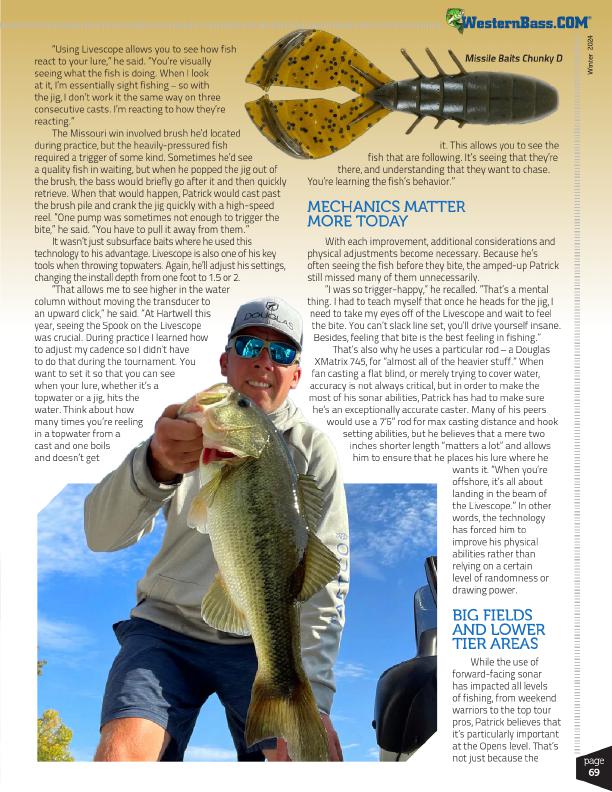
®
“Using Livescope allows you to see how fish react to your lure,” he said. “You’re visually seeing what the fish is doing. When I look at it, I’m essentially sight fishing – so with the jig, I don’t work it the same way on three consecutive casts. I’m reacting to how they’re reacting.”
The Missouri win involved brush he’d located during practice, but the heavily-pressured fish required a trigger of some kind. Sometimes he’d see a quality fish in waiting, but when he popped the jig out of the brush, the bass would briefly go after it and then quickly retrieve. When that would happen, Patrick would cast past the brush pile and crank the jig quickly with a high-speed reel. “One pump was sometimes not enough to trigger the bite,” he said. “You have to pull it away from them.”
It wasn’t just subsurface baits where he used this technology to his advantage. Livescope is also one of his key tools when throwing topwaters. Again, he’ll adjust his settings, changing the install depth from one foot to 1.5 or 2.
“That allows me to see higher in the water column without moving the transducer to an upward click,” he said. “At Hartwell this year, seeing the Spook on the Livescope was crucial. During practice I learned how to adjust my cadence so I didn’t have to do that during the tournament. You want to set it so that you can see when your lure, whether it’s a topwater or a jig, hits the water. Think about how many times you’re reeling in a topwater from a cast and one boils and doesn’t get
Missile Baits Chunky D
it. This allows you to see the
fish that are following. It’s seeing that they’re
there, and understanding that they want to chase. You’re learning the fish’s behavior.”
MECHANICS MATTER MORE TODAY
With each improvement, additional considerations and physical adjustments become necessary. Because he’s often seeing the fish before they bite, the amped-up Patrick still missed many of them unnecessarily.
“I was so trigger-happy,” he recalled. “That’s a mental thing. I had to teach myself that once he heads for the jig, I need to take my eyes off of the Livescope and wait to feel the bite. You can’t slack line set, you’ll drive yourself insane.
Besides, feeling that bite is the best feeling in fishing.”
That’s also why he uses a particular rod – a Douglas
XMatrix 745, for “almost all of the heavier stuff.” When fan casting a flat blind, or merely trying to cover water, accuracy is not always critical, but in order to make the most of his sonar abilities, Patrick has had to make sure
he’s an exceptionally accurate caster. Many of his peers
would use a 7’6” rod for max casting distance and hook
setting abilities, but he believes that a mere two
inches shorter length “matters a lot” and allows
him to ensure that he places his lure where he
wants it. “When you’re
offshore, it’s all about
landing in the beam of
the Livescope.” In other
words, the technology
has forced him to
improve his physical
abilities rather than
relying on a certain
level of randomness or
drawing power.
BIG FIELDS AND LOWER TIER AREAS
While the use of forward-facing sonar has impacted all levels of fishing, from weekend warriors to the top tour pros, Patrick believes that it’s particularly important at the Opens level. That’s not just because the
Winter 2024
page 69